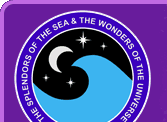1971

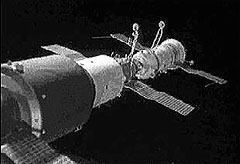
Public Domain Image
April 19, 1971
First Space Station
The Salyut 1 space station is launched by the Soviet Union and becomes the first space station in orbit around the earth. It remains in orbit until May 28, 1973. The Salyut program continues with five more successful launches of seven more stations.

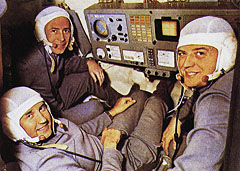
Public Domain Image
June 6, 1971
First Occupation of Space Station
Soyuz 11 carries Cosmonauts G.T. Dobrovolsky, V.N. Volkov, and V.I. Patsayev to the Salyut 1 station in the first manned occupancy of an orbital space station. Tragically, on June 29, the three Cosmonauts are killed when the crew capsule depressurizes while preparing for reentry. They become the first humans killed in space.

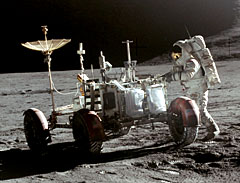
NASA Public Domain Image
July 30, 1971
First Lunar Rover Mission
Apollo 15 astronauts David Scott and James Irwin drive the first Lunar Roving Vehicle (LRV) while exploring the surface of the Moon. The next year, Apollo 17 astronaut Harrison Schmitt drives a similar rover. Known also as the Moon Buggy, the LRV weighs 460 pounds (210 kg) without payload. It can carry a maximum payload of 1,080 pounds (490 kg) including two astronauts, equipment, and lunar samples.

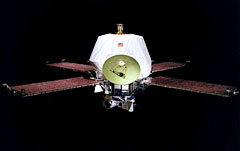
NASA Public Domain Image
November 14, 1971
First Spacecraft to Orbit Another Planet
American space probe Mariner 9 arrives at the planet Mars and becomes the first spacecraft to orbit another planet. Over the next year, it maps 100 percent of the Martian surface. The spacecraft returns 7,329 images of the red planet over the course of its mission, which concludes in October of 1972.
1972

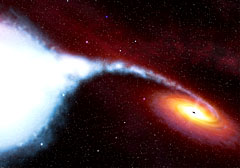
ESA Copyright Free Use Image
December, 1972
First Black Hole Candidate
Astronomers designate Cygnus X-1 as the first probable black hole. This binary star system emits strong bursts of X-rays as matter is literally crushed out of existence by the black hole. It is one of the strongest X-ray sources seen from Earth.
1973

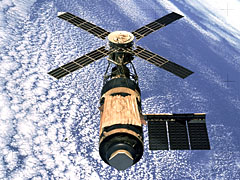
NASA Public Domain Image
May 14, 1973
First U.S. Space Station
NASA launches Skylab, the first United States space station. The station experiences some damage during launch but will be repaired and occupied by three crews over the next few years. It also will become an important platform for a number of scientific experiments.

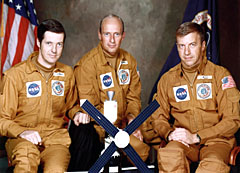
NASA Public Domain Image
May 25, 1973
First Skylab Crew
The United States launches Skylab 2, carrying the first crew to visit the new Skylab station. The three-member crew repairs damage sustained by Skylab station during its launch. They spend 28 days in space, setting a new space duration record for American astronauts.
1975

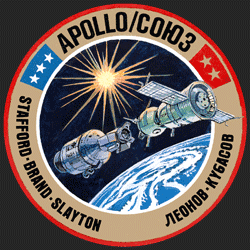
July 17, 1975
First International Space Rendezvous
American Apollo and Soviet Soyuz spacecraft dock in what is the first international spacecraft rendezvous. Known as the Apollo-Soyuz Test Project, this important mission proves that U.S. and Russian crews can work together successfully in space. The Apollo spacecraft is launched with a special docking mechanism to allow the two spacecraft to join together. While docked, the two crews perform both joint and separate scientific experiments, including an arranged eclipse of the Sun.

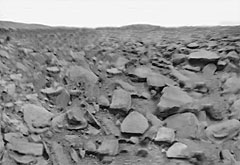
Public Domain Image
October 22, 1975
First Surface Images of Venus
The Soviet Venera 9 spacecraft lands successfully on Venus and sends the first pictures of the Venusian surface back to Earth. The spacecraft also takes measurements of the planet's atmosphere before being destroyed by the intense heat and pressure.
1976

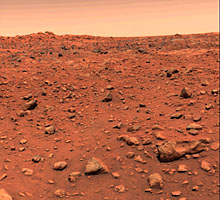
NASA Public Domain Image
July 20, 1976
First Surface Images of Mars
The first pictures of the surface of Mars are sent back to Earth by Viking 1, the first U.S. spacecraft to successfully land on another planet. It is the second spacecraft to make a soft landing on Mars and the first to successfully perform its mission. Viking 1 photographs the surface and reveals a rocky, desolate landscape that shows no signs of life.

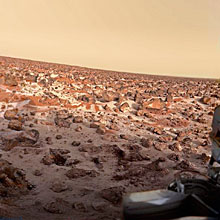
NASA Public Domain Image
September, 1976
Discovery of Water Frost on Mars
Following the success of Viking 1, the Viking 2 spacecraft lands on Mars in the Plain of Utopia. It discovers and photographs water frost and sends back stunning images of the Martian surface. Viking 2 operates on the surface for 1,316 Earth days (1,281 Martian days or sols), and is turned off on April 12, 1980 when its batteries fail.
1977

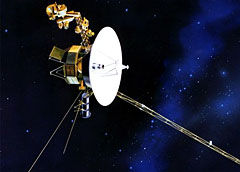
NASA Public Domain Image
August-September, 1977
Launch of Historic Voyager Missions
The Voyager 1 and Voyager 2 spacecraft are launched into space on an epic tour of the Solar System. Their long journey will take them to the outer planets and give us our first views of these mysterious worlds. The two spacecraft will soon encounter Jupiter in 1979 and Saturn in 1980.
1978

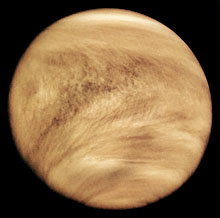
NASA Public Domain Image
December, 1978
U.S. Probes Arrive at Venus
Two U.S. Pioneer spacecraft reach the planet Venus. The Pioneer Venus Orbiter enters orbit around Venus on December 4, 1978, and performs observations of the planet's atmosphere and cloud layers. The Pioneer Venus Multiprobe spacecraft deploys four small probes into the Venusian atmosphere on December 9, 1978. All four probes transmit data throughout their descent to the surface.
1979

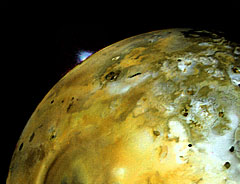
NASA Public Domain Image
March 5, 1979
Voyager 1 Arrives at Jupiter
The U.S. Voyager 1 spacecraft, launched in 1977, finally arrives at Jupiter and begins sending back amazing images of the giant planet and its moons. The spacecraft passes within 217,000 miles (349,000 kilometers) of the planet's center. Voyager 1 discovers volcanic activity on Jupiter's moon Io. This is the first time active volcanoes have been seen on another body in the Solar System.

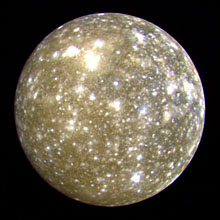
NASA Public Domain Image
July 9, 1979
Voyager 2 Arrives at Jupiter
The U.S. Voyager 2 spacecraft, launched in 1977, arrives at Jupiter and begins sending back images of Jupiter and its moons. It passes within 350,000 miles (570,000 kilometers) of the planet's cloud tops. Voyager 2 returns images of Jupiter, as well as its moons Amalthea, Io, Callisto, Ganymede, and Europa. It also confirms Voyager 1's observations of active volcanoes on Jupiter's moon Io. Three new moons were also discovered.

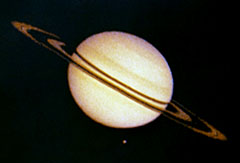
NASA Public Domain Image
September 1, 1979
First Images of Saturn
The U.S. space probe Pioneer 11 reaches Saturn, flying within 13,000 miles (21,000 kilometers) of the planet's cloud tops. It sends back the first closeup photographs of the ringed planet. The spacecraft discovers another moon and another ring. It also studies the planet's magnetosphere and magnetic field and discovers that the moon Titan is too cold for life.
1980

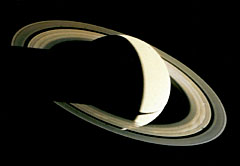
NASA Public Domain Image
November 12, 1980
Voyager 1 Arrives at Saturn
The Voyager 1 spacecraft arrives at Saturn and begins sending back extraordinary images of the ringed planet and its many moons. The probe passes within 77,000 miles (124,000 kilometers) of Saturn's cloud tops. Voyager 1's cameras detect complex structures in the rings, and its remote sensing instruments study the atmospheres of Saturn and its moon Titan.
